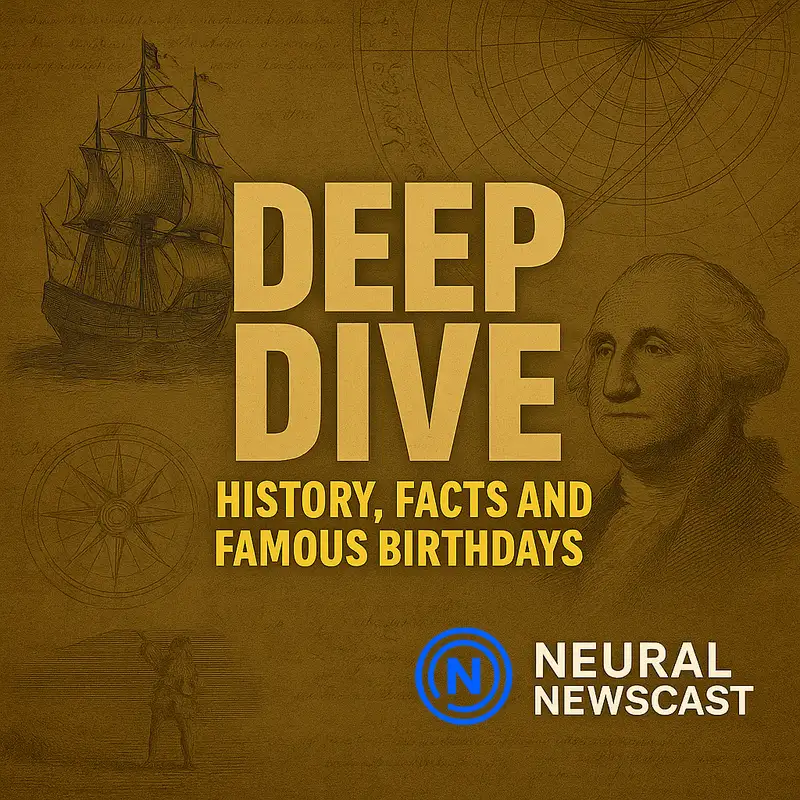Deep Dive: Graceland, Julia Child, and the Hidden Cables That Connect the World - August 16, 2025
AI delivers the news. Human editors ensure its accuracy. This is Neural Newscast.
Get ready for a deep dive from Neural Newscast. I'm Jessica,
and Natalie is here with me as we delve into today's subjects. Elvis' death at Graceland
in 1977 felt like the end of an era, didn't it? An instant global pause where music lovers
everywhere realized a seismic figure was gone.
The images of fans gathered outside Graceland are still so vivid.
Absolutely. There's something about that personal, almost cinematic setting of Graceland
that makes the loss feel intimate, not just headline-sized,
and the way fans reacted, flowers, vigils, spontaneous sing-alongs,
shows how his music had threaded into daily life.
Right, and as a traveler I always think about place.
Graceland became more than a home.
It transformed into a pilgrimage site almost overnight,
a cultural landmark where people sought connection
to the man behind the legend.
And that pilgrimage had a flavor to it, literally.
Memphis poured its soul into the streets,
from barbecue joints to jukebox diners playing his records,
Food and music together carried grief and celebration at once.
I love that image.
People standing in line for ribs while someone nearby is playing suspicious minds on a guitar.
Grief woven into everyday rituals,
turning ordinary sights into memory-making spaces.
There's also how Elvis bridged cultures through sound.
His blending of gospel, country, and rhythm and blues
influenced not only musicians but the way communities ate and socialized too.
Clubs, record stores, diners became shared cultural hubs.
It's interesting how a single figure can catalyze that
after his death, the preservation of Graceland and the surge in memorabilia
created a new kind of cultural tourism economy around rock history.
And for culinary culture, that economic shift mattered.
Tourists seeking authenticity wanted local flavors, so neighborhood kitchens and homey southern spots saw new faces.
People craving the comfort foods Elvis himself loved, or at least the stories about them.
That ties into legacy.
His passing didn't just pause a career.
It amplified influence, turning songs into communal rituals and places into shrines.
Even now, visiting Graceland or hearing his records connects you to that moment in 1977.
Exactly. There's this dual sense of mourning and celebration in the air that never quite left.
Chefs and musicians alike reference Elvis as inspiration, sometimes literal, like his favorite peanut butter and banana sandwich showing up on menus as a playful homage.
That sandwich is practically folklore at this point.
Small details like that humanize him, letting visitors and fans feel closer.
They make the pilgrimage tangible, a sensory link to history.
Sensory is the right word.
Sound, taste, sight.
All play into how people process the loss.
The worldwide outpouring showed music's reach.
Grief became a kind of communal song,
and food scenes provided the practical warmth
to hold that emotion.
And on a broader cultural level,
his death crystallized rock, Nen,
roles place in modern identity.
It forced a moment of reflection on fame, fandom,
and how cultural icons shape the places they inhabit.
It also sparked conversations about health and the pressures of stardom, right?
Those discussions influenced how artists and communities thought about care and sustainability in their industries.
Yes, and as someone who tells travel stories,
that blend of celebration and caution makes places like Graceland layered,
Tourists come for the glamour and stay for the complex history.
For food culture, those layers show up in menus that honor tradition while acknowledging the weight of history.
Comfort food becomes storytelling, a way to respect a legacy while moving forward.
In the end, Elvis' death in 1977 did more than close a chapter on an artist's life.
It reshaped cultural landscapes, turned private grief into public ritual, and left physical
sites and traditions that still draw people together.
And those rituals, whether a sing-along outside Graceland or a diner serving up that famous
sandwich, keep the conversation alive, letting new generations taste and hear why that moment
mattered so much.
Thank you.
Today we celebrate the birthdays of Agatha Christie, 1890,
Marcel Proust, 1871, and Julia Child, 1912.
Boo! Julia Child.
Such a treasure to talk about,
especially from a food perspective.
Absolutely, but quick note.
Proust predates Christie chronologically, right?
The list order was chronological in the prompt,
so we'll focus on one.
Julia Child feels perfect for our mix of travel and food flavor.
Yes, Julia it is.
She reshaped how Americans approached French cooking, but she was more than a chef on TV.
She was a translator of culture.
I love that translator of culture.
Her life reads like an adventure.
Started late in the kitchen in her 30s, after wartime service and a stint at the OSS, then
off to La Cordon Bleu in Paris.
Its travel and reinvention wrapped into one.
And technically brilliant, she insisted on understanding the foundations,
sauces, knife skills, timing.
But she made technique approachable on camera,
with real-time mistakes and laughter.
That candor changed culinary TV.
Right. That authenticity made viewers feel like they could cross an ocean
and participate in someone else's kitchen.
She brought France into American homes not as an exotic postcard,
but as a lived experience.
Markets, butter, the ritual of a good stock.
Little-known fact.
She was actually involved in intelligence work during World War II,
which is where she met Paul Child.
Their partnership mattered.
He supported her career, photographed recipes, and handled so much of the behind-the-scenes logistics.
Paul's photography and encouragement were pivotal.
And another neat detail.
When she co-wrote Mastering the Art of French Cooking,
it took years of testing in American kitchens to adapt measurements and techniques
so home cooks could actually reproduce the dishes.
Exactly.
American ovens, ingredient availability, portion sizes.
She translated not just language but practicality.
That book is as much anthropology as it is a cookbook.
Her TV presence, slow, deliberate, often wearing practical clothes rather than glam,
felt like a travel guide narrator who's inviting you to savor each stop
She demystified things like Betchamil, the way a good guide demystifies a local ritual.
And she loved butter.
Like unapologetically.
She'd say it makes everything taste better, and she wasn't being flippant.
She understood fat's role in flavor chemistry, which chefs and home cooks still debate.
That unabashed love for taste ties back to culture.
Food as joy, community, and memory.
Her programs made French technique accessible,
but also made the idea of slow, pleasurable cooking respectable
during a time of increasingly convenient food.
She also mentored an entire generation of cooks and food writers.
Her influence is in how culinary education is presented, clear, narrative-driven, and rooted in technique.
You can trace modern cooking shows back to her format.
And on the travel side, she nudged Americans to see France as more than a postcard,
as a place of markets, regional differences, and cooking as a way of life.
That encouraged a deeper curiosity in travel cooking.
Do you remember that bit about her insisting on weighing ingredients because volume measures were unreliable?
It sounds small, but it made a huge difference in reproducibility.
Pure practical science.
That precision is part of her legacy,
merging scientific rigor with storytelling warmth.
It's why her work still reads and watches, well, decades later.
Her legacy keeps turning up.
In chefs who champion technique, in food TV that values teaching, and in home cooks who
feel empowered, not intimidated.
Julia transformed cuisine, media, and even travel curiosity.
Her impact persists because she taught people to approach food as a doorway to culture
and connection.
And that lasting relevance, that invitation to explore, taste, and learn is what
is what makes celebrating her birthday feel meaningful even now.
We'll be right back after this short break.
This is NNC, Neural Newscast.
And we're back with more from Neural Newscast Deep Dive.
Can you believe that over 95% of international internet traffic
actually travels along submarine fiber optic cables
strewn across the ocean floor, not by flashy satellites up in space?
That always blows people's minds.
Me included, the first time I heard it, you picture satellites everywhere.
But really it's these hidden threads under the sea doing the heavy lifting.
Exactly.
And as a travel reporter, I'm fascinated by the geography of it.
These cables literally connect continents, often taking the most unexpectedly practical
routes, hugging continental shelves and avoiding volcanic zones.
And from a food travel angle, it's wild to think that the recipe for your restaurant's booking system
or your favorite food podcast episode probably rode these same cables between countries.
So many culinary connections depend on them.
Right. Think about live-streamed street food tours or a last-minute visa form for a remote island.
Without those undersea links, the latency would spike, and those experiences would feel totally different.
There's also this tactile, almost romantic element.
Technicians laying kilometers of glass fiber in the dark, cold sea,
and then chefs on the other side plating ephemeral moments for diners that rely on that invisible infrastructure.
And it's not just romance.
There are practical vulnerabilities.
Shipping anchors, earthquakes, even sharks have been known to damage cables,
causing regional outages that ripple through banks, airports, and yes, restaurants.
I remember one incident where a severed cable caused payment systems to fail at markets in a whole country.
Chefs had to revert to handwritten tickets and cash, and service rhythms changed overnight.
Those stories remind me how geopolitics and economics shape where cables land.
Landing stations are strategic hubs, and countries compete to be on those maps because it affects speed, cost, and digital sovereignty.
Which then affects food culture too.
Faster connections mean more international collaborations,
remote consulting with chefs,
or streaming a cooking class across oceans without that frustrating lag.
There's also a sensory side I love imagining,
the scale of the engineering,
giant cable ships spooling fiber as if sewing the continents together,
and tiny microscopic pulses of light
carrying whole libraries and live conversations.
The tech nerd in me loves that it's light.
You're literally sending photons through glass to transmit a recipe,
a critique, an order.
It's poetic and so efficient compared to radio waves going skyward.
And despite satellites being high profile, they're complimentary.
Satellites cover remote areas and resilience,
but the bulk of high-capacity, low-latency traffic stays underwater on those fibers.
So next time we stream a street food tour or place an online reservation,
we should picture those deep-sea cables humming along.
It's oddly comforting, and it gives you a new appreciation for the invisible supply chain behind travel and food.
Totally.
Seeing travel through the lens of infrastructure makes destinations feel more connected and alive.
Those cables are almost like maritime terroir,
shaping how cultures and cuisines circulate.
I love that, maritime terroir,
because food culture literally rides those lines,
bringing recipes, reviews, and relationships
across oceans in the blink of an eye.
And knowing that tiny changes,
like a new cable or a repaired fault,
can transform access to information in a region,
makes me want to map these routes next time I plan a story.
Same here.
I'm already imagining a feature on kitchens that went digital thanks to improved cable links,
chefs collaborating internationally in real time.
There's a whole delicious angle in that connectivity.
Thanks for tuning into our Deep Dive.
I'm Natalie, and from Jessica and the Neural Newscast team, we'll see you next time.
You've been listening to Neural Newscast.
AI-powered human-reviewed.
Keep up with us on XBumble and Facebook and dive deeper at NeuralNewscast.com.
Neural Newscast combines real voice recordings with synthesized voices to enable prompt production
without sacrificing quality.
All content is generated using advanced AI algorithms developed by a human
and undergoes fact-checking and human review prior to release.
While we strive for factual, non-biased reporting and actively work to prevent AI hallucinations,
AI-generated content can occasionally contain errors.
Listeners are encouraged to verify critical information from trusted sources.
For more details on our AI transparency policies, visit nnewscast.com.
Creators and Guests


